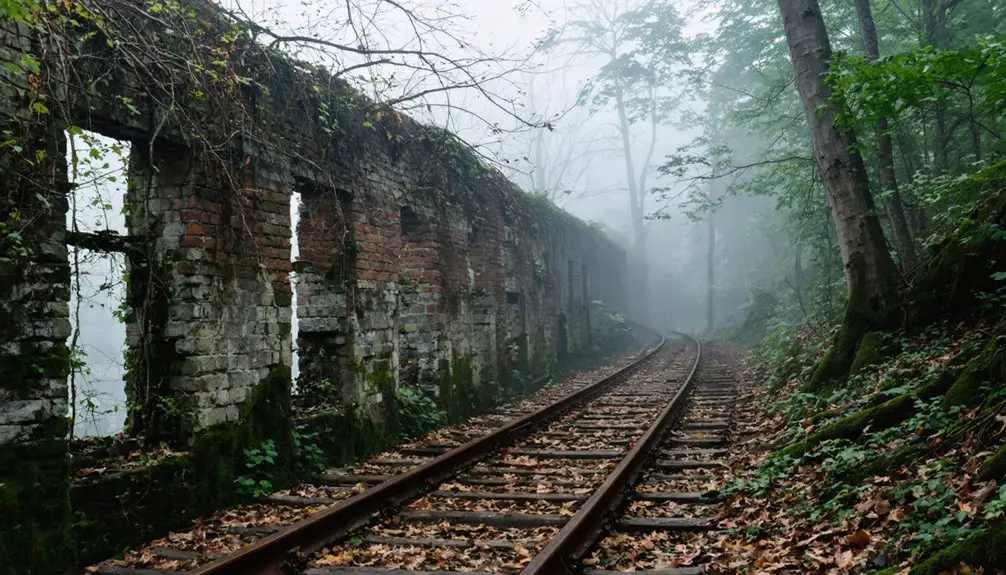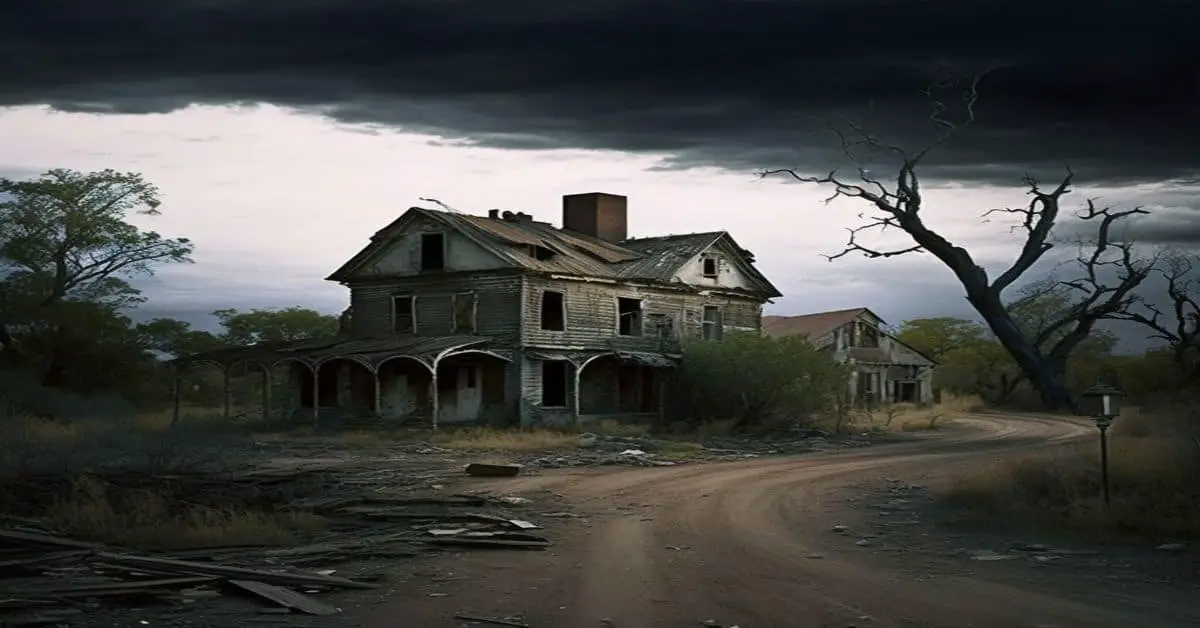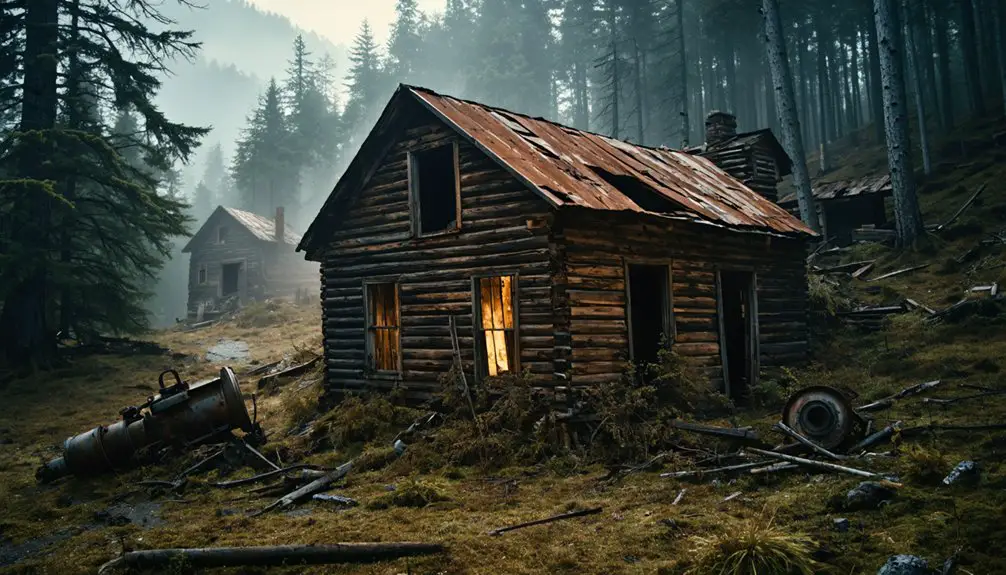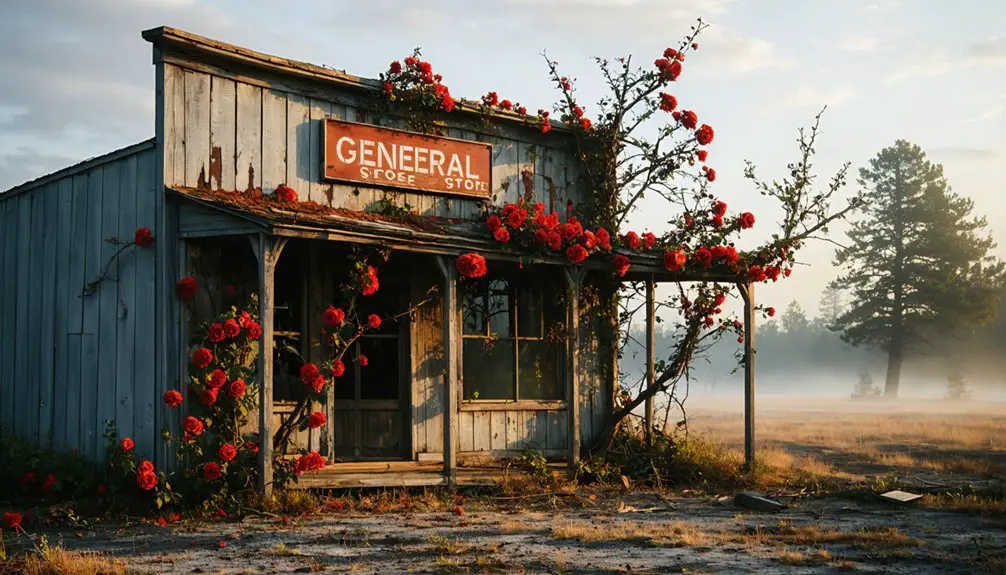You’ll find the ruins of Daniels, Maryland tucked within Patapsco Valley State Park, where a bustling mill town once thrived from 1810 until 1972. Originally called Elysville, this company-owned community grew around a textile mill that employed 250 workers and controlled local housing, stores, and services. When Tropical Storm Agnes struck in 1972, it delivered the final blow to this already-declining town, leaving behind stone foundations and church ruins that tell a deeper story of American industrial life.
Key Takeaways
- Daniels was a thriving mill town established in 1810 that became abandoned after housing closures in 1968 and devastating floods in 1972.
- The town’s remains are now part of Patapsco Valley State Park, with ruins of the textile mill dissolving into the surrounding forest.
- C.R. Daniels’ closure of company housing forced families to leave, effectively ending the community’s century-long existence as a company town.
- Church foundations, including Saint Stanislaus Kostka and Pentecostal Holiness, are among the few visible remnants of the former town.
- Tropical Storm Agnes in 1972 caused extensive damage to remaining structures, accelerating the town’s transformation into a ghost town.
The Rise of a Mill Town (1810-1940)
When Thomas Ely and his four brothers established a textile mill along the Patapsco River in 1810, they laid the foundation for what would become a thriving industrial community.
Originally named Elysville, the settlement’s identity transformed in 1853 when James S. Gary purchased the property and renamed it Alberton after his son.
You’ll find the town’s textile production evolved considerably during this period. The main mill building, completed in 1846, initially produced cotton textiles for Oskiska Manufacturing.
Under Gary’s ownership, the mill specialized in cotton duck material and later expanded to include denim, sheeting, and Oshburgs. The mill employed an average of 250 workers from the local community.
The B&O Railroad‘s arrival in 1831 boosted the town’s growth, while community identity centered around mill-owned amenities including a general store, churches, library, and recreational facilities. The property was eventually sold to C.R. Daniels Company for sixty-five thousand dollars in 1940.
Industrial Legacy Along the Patapsco
Along the banks of the Patapsco River, the industrial legacy of what began as Elysville left an indelible mark on Maryland’s manufacturing history.
You’ll find traces of industrial resilience in the remnants of the three-and-a-half-story mill that C.R. Daniels purchased in 1940 for $65,000, later expanding it to produce Dandux products.
The B&O Railroad‘s strategic presence transformed this mill town, connecting it westward to Point of Rocks and enabling efficient transport of timber and coal.
The community’s identity flourished around the mill, supporting 250 workers and 90 families with company housing, stores, schools, and churches. Thomas Ely and family established the town’s foundation in 1810 when they built the first textile mill.
Life revolved around the bustling mill, where workers and their families found not just jobs, but a complete community.
The town was renamed in 1853 when the Alberton Manufacturing Company acquired ownership.
Despite the prosperity, nature ultimately prevailed when Hurricane Agnes struck in 1972, devastating the industrial complex and forcing C.R. Daniels to relocate to Ellicott City.
Life in a Company-Owned Community
You’d find every aspect of daily life in Daniels under the direct control of the mill companies, which owned not only the workers’ homes but also the general store, post office, and recreational facilities.
If you were a resident, you’d need employment at the mill to maintain your housing, as the company’s ownership of the entire village created a wholly dependent community of around 250 workers and their families. To ensure historical accuracy and proper navigation, place name disambiguation helped distinguish this Daniels from other locations sharing the name.
Your social and recreational activities would revolve around company-owned venues like the bowling alley, pool hall, and ball field, though the two churches – St. Stanislaus Kostka Catholic Church and Pentecostal Holiness Church – remained independent of mill ownership. The town thrived until Hurricane Agnes flooding in 1972 devastated the area, leading to its eventual abandonment.
Mill Control Over Living
During the mid-20th century, C.R. Daniels Company exercised complete control over the lives of its mill workers through extensive property ownership.
You’d find yourself living in company-owned housing, shopping at the company store, and sending your children to company-controlled schools. The company acquired the community after purchasing it from the Gary family in 1940. The company’s dominance extended beyond the workplace, influencing every aspect of daily life through ownership of churches, the post office, and essential infrastructure.
Worker dependency was reinforced by the mill’s position as the primary employer, with about 250 jobs at its peak. You couldn’t easily escape the company’s influence – they owned the entire 500-acre village, purchased for $65,000 in 1940.
This control lasted until 1968, when the company began closing worker housing, marking the beginning of the end for this tightly controlled community.
Daily Life and Services
Life in the company-owned community of Daniels revolved around a close-knit network of services and facilities designed to meet residents’ daily needs.
You’d find your daily routines centered around the company stores for essentials like food and clothing, while community interactions often took place at local churches that served as social hubs.
Your mail would arrive through the post office that operated from 1943 to 1971, keeping you connected to the outside world.
While you’d have access to basic education for your children and some healthcare through company resources, your options remained limited by the town’s isolation.
The devastating impact of Hurricane Agnes in 1972 severely damaged many of the town’s buildings and infrastructure.
At its peak in the late 1960s, you’d share the community with about 90 other families, all living in company-provided housing near the textile mill.
Residents made do with minimal amenities, as homes only had access to cold water from a nearby reservoir.
The Final Days of Operation
As industrial decline gripped the region in 1968, C.R. Daniels Company announced plans to close all housing in the town, triggering a community exodus of approximately 90 families.
The economic downturn led to systematic dismantling of key infrastructure, including the demolition of Saint Stanislaus Kostka Catholic Church and the local school.
While mill operations continued briefly, the post office ceased operations by 1971, marking the end of official community functions.
The final blow came in June 1972 when Tropical Storm Agnes devastated the Patapsco River Valley, washing away most remaining structures.
The State of Maryland subsequently condemned the site, incorporating it into Patapsco Valley State Park.
What was once a thriving industrial town became a restricted area, its ruins standing as silent witnesses to its industrial past.
Nature’s Reclamation of Daniels
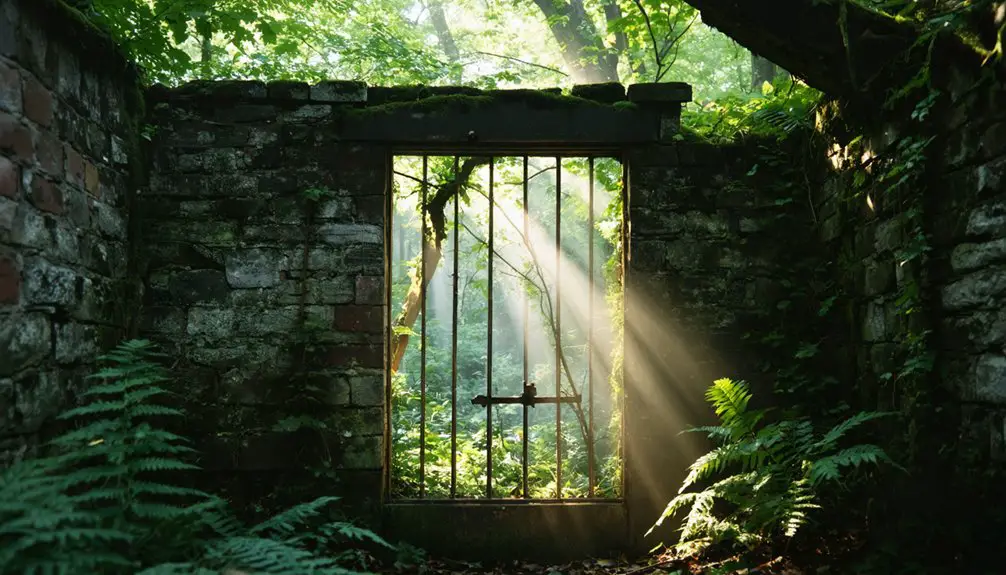
Since the town’s abandonment in 1972, nature has steadily reclaimed the once-bustling industrial community of Daniels. Dense forest vegetation encroachment has transformed the landscape, with vines and brush consuming old buildings while fallen trees obscure former streets.
You’ll find abandoned vehicles now covered in moss, slowly dissolving into the wilderness around them.
Wildlife resurgence marks nature’s triumph, as birds, small mammals, and insects have established new homes among the ruins. The Patapsco River’s periodic floods have reshaped the terrain, depositing nutrient-rich sediment that feeds the expanding forest. The textile mill closure in 1968 marked the beginning of the town’s population decline.
Even the old church and cemetery haven’t escaped nature’s grasp, with St. Stanislaus Kostka’s stone remnants weathering under persistent natural forces while tombstones sink into the overgrown grass.
What Remains: Exploring the Ruins
If you’re exploring Daniels today, you’ll find the stark remains of the textile mill buildings slowly dissolving into the surrounding forest, with rotting wood and worn stone gradually yielding to vegetation.
The stone foundations of the Pentecostal Holiness Church and Saint Stanislaus Kostka Church still mark their original locations, though both structures were abandoned after devastating events – flooding and fire respectively.
Nature’s steady reclamation hasn’t completely erased these architectural footprints, as stone walls and foundations persist amid the encroaching woodland, offering tangible connections to the town’s past.
Nature Reclaims Mill Ruins
The ruins of Daniels’ once-thriving textile mill stand as haunting reminders of Maryland’s industrial past, now slowly disappearing beneath nature’s persistent advance.
As you explore the site, you’ll witness dramatic ecological succession in action – vines snake through crumbling concrete, while trees thrust their roots into century-old foundations. The 1972 flooding from Tropical Storm Agnes accelerated this urban decay, leaving the mill’s remaining structures even more vulnerable to nature’s reclamation.
Today, the concrete dam and scattered stonework peek through a vibrant tapestry of wild vegetation.
You’ll find the Patapsco River’s waters flowing past moss-covered walls where factory machines once hummed. The ruins have become an unintended sanctuary where wildlife thrives among the weathered remnants of industrial ambition.
Church Foundations Still Stand
Among Daniels’ most enduring ruins stand two poignant symbols to its spiritual past – Saint Stanislaus Kostka Catholic Church and the Pentecostal Holiness Church.
You’ll find Saint Stanislaus’ stone gothic church architecture, struck by lightning in 1926, now reduced to foundations along a dusty county road. Behind it lies a weathered graveyard where a few headstones still defy time.
The Pentecostal Holiness Church foundations reveal another chapter of community importance, standing defiantly despite Tropical Storm Agnes’ devastating floods in 1972.
While both churches’ stone remnants have outlasted the town’s wooden structures, nature slowly reclaims them through vegetation and weathering.
These sacred spaces, once crucial centers of worship and gathering, now serve as silent witnesses to Daniels’ vanished community life.
Preserving the Memory of a Lost Town
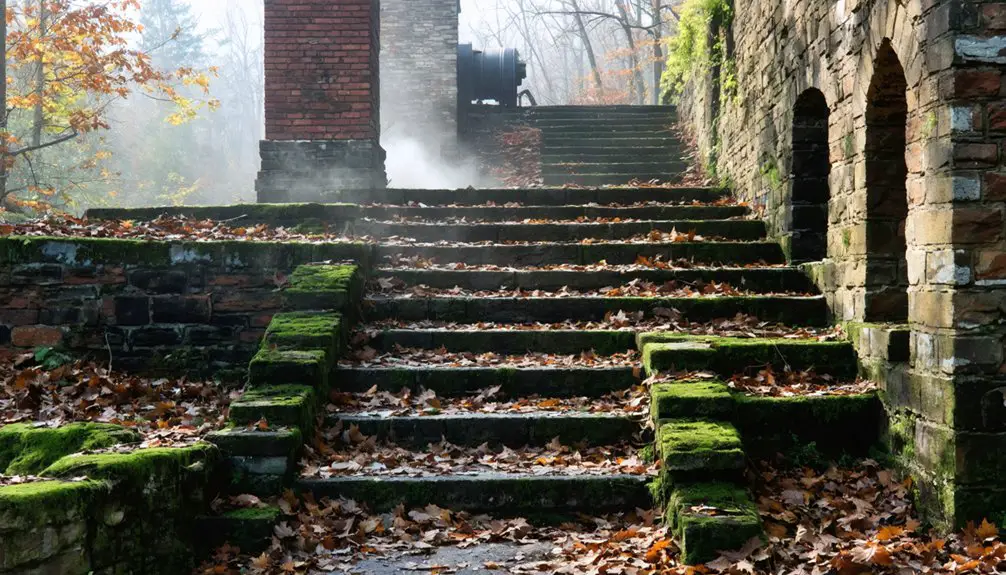
Preserving memories of Daniels, Maryland presents unique challenges as this once-thriving mill town gradually fades into obscurity. Yet, you’ll find its historical significance lives on through community stories, archived documents, and the dedicated work of local historians who’ve collected oral histories from former residents.
You can explore Daniels’ legacy through various channels. The town’s industrial heritage is commemorated by its listing on the National Register of Historic Places, while archaeological surveys continue to uncover details about 19th and 20th-century mill life.
Within Patapsco Valley State Park, you’ll discover interpretive trails that guide you through the ruins, offering glimpses into the past. Local historical societies maintain collections of photographs and documents, ensuring that even as nature reclaims the physical town, its memory endures for future generations.
Frequently Asked Questions
Are There Any Documented Paranormal Activities or Ghost Sightings in Daniels?
Like whispers in the wind, you’ll find ghostly encounters in Daniels aren’t officially documented, though haunted legends persist around EMF readings near an old bathtub and the children’s cemetery from 1912-1919.
What Happened to the Residents Who Were Forced to Leave?
You’ll find historical accounts show the displaced families scattered across Howard and Baltimore counties, making independent choices about relocation with no company assistance, severing long-established community bonds in the process.
Can Visitors Legally Explore the Ruins of Daniels Today?
You can legally explore Daniels’ ruins within Patapsco Valley State Park from dawn to dusk, following park exploration permissions and legal regulations. Stay on marked trails and respect the remaining structures.
Were There Any Notable Accidents or Deaths at the Mill?
You might expect grim tales of mill accidents and tragic deaths, but historical records don’t document any notable industrial casualties at Daniels Mill during its long operation from 1810-1968.
Did Any Original Artifacts From the Town Get Preserved in Museums?
You won’t find many formal museum exhibits of Daniels’ artifacts. While the mill’s listed on the National Register, most remnants stay onsite as ruins within Patapsco Valley State Park rather than preserved collections.
References
- https://en.wikipedia.org/wiki/Daniels
- https://www.abandonedspaces.com/uncategorized/now-entirely-reclaimed-nature-ghost-town-daniels-marylandwas-thriving-mill-town.html
- https://www.atlasobscura.com/places/daniels
- https://midatlanticdaytrips.com/2020/11/does-daniels-marylands-ghost-town-actually-have-ghosts/
- https://midatlanticdaytrips.com/2015/10/visiting-marylands-ghost-town-daniels/
- https://granitehistoricalsociety.org/?p=121
- https://www.patapsco.org/discovery/daniels-alberton-elysville/
- https://www.thevintagenews.com/2016/06/21/flooded-1972-ghost-town-daniels-lives-collection-memories/
- https://www.mindat.org/loc-251729.html
- https://www.patapsco.org/wp-content/uploads/Discover-Daniels-Day-Panel_1_2012_Daniels_1830-1972.pdf
